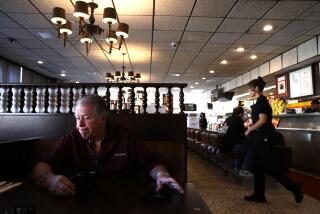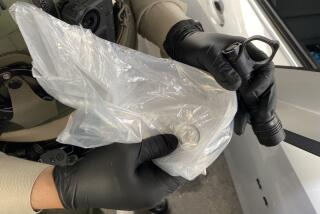New Fear on Medfly Outbreak : Infestation: The leading scientific adviser to the eradication effort says the problem is widespread. County officials say the outbreaks are isolated incidents.
As a seventh outbreak of fertile Mediterranean fruit flies was reported in Los Angeles County, the leading scientific adviser to the eradication effort conceded Wednesday that it now appears likely the outbreaks constitute a single infestation of the pest.
While saying “there is no way we can know for sure,” Roy Cunningham, U.S. Department of Agriculture entomologist in Hawaii and a member of a five-member expert panel advising the state and county eradication effort, acknowledged that “if you look at the map there is a smear of flies going from Whittier up north to San Fernando. The attitude is that we are going to have to treat this as one huge area. . . . This is certainly bigger than anything we ever expected.”
With his assessment, Cunningham appeared to break ranks with county officials who have maintained that the infestations dotting the Los Angeles Basin are isolated outbreaks. Two members of the advisory panel last week suggested a linkage in the infestations and called for a more aggressive attack.
The distinction is important. Universal recognition that the county is battling a single, widespread--and escalating--infestation would make even trickier the sensitive balancing act between the interests of farmers to eliminate the Medfly by whatever means necessary and the concerns of local residents about increased pesticide applications.
County Agricultural Commissioner Leon Spaugy held firm Wednesday to his opinion that the infestations are independent and confined to nine square miles around the seven sites where fertile Medflies have been trapped.
“I do not consider this out of control. I consider them separate infestations,” Spaugy said. “We have a handle on it. . . . If if was continuous, we would be finding flies in other pockets of the county.”
The new North Hollywood discovery, however, is certain to escalate what has already become the worst infestation in Los Angeles County history. County and state agricultural officials ordered aerial pesticide spraying Monday night over the 12-square-mile sector in North Hollywood, Toluca Lake, Studio City and Burbank. Spaugy would not rule out the possibility that two or more aerial applications of malathion might be needed.
Earlier this week, officials in charge of the eradication campaign said they were forced to abandon a policy of using only one aerial spraying because they have nearly run out of sterile Medflies, which are released by the millions to breed out of existence any wild flies that survive the pesticide spraying.
Gov. George Deukmejian “fully supports” the prompt spraying of pesticide over infested zones and “believes that the public is supportive because of the clear damage that the Medfly can bring to California’s top industry,” said his spokesman, Kevin M. Brett.
Asked if the governor supports multiple applications of malathion over residential neighborhoods, Brett said Deukmejian believes that the Medfly combatants should use “whatever is at their disposal.”
The Medfly lays its eggs in more than 250 varieties of fruits and vegetables, rendering the produce unfit for market. An estimated $1.75 billion in agricultural products that could be infected with contaminated by the Medfly are shipped throughout Los Angeles each year. Statewide, agriculture is a $14-billion-a-year industry.
After an hourlong conference call Wednesday, state and county government officials bowed to the recommendations of the scientific panel and agreed to double trapping efforts countywide. This step is intended to more quickly detect the crop-destroying pest.
“It is clear that Los Angeles is the problem child for the state when it comes to Medflies,” Cunningham said. “It think it is prudent to spend more money here so that we can catch the fly in earlier stages.”
The price tag to fight the Medfly so far this year has exceeded $10 million in Los Angeles, paid for largely by emergency state funds.
Malathion is to be sprayed tonight over a 22-square-mile swath of East Los Angeles and the San Gabriel Valley. The same sector is to be sprayed again in two weeks. Additionally, a second application of malathion will be sprayed Nov. 28 over another 22-square-mile area that includes El Monte, Rosemead and San Marino.
The state is applying the pesticide under a special permit from the U.S. Environmental Protection Agency for emergency spraying over residential areas. The EPA last year ordered new studies to determine any possible association between the chemical and cancer, birth defects or developmental problems as part of what officials called a “routine” review.
Previous studies failed to show any clear association with such adverse health effects, but some of the investigations were poorly designed and should be repeated, federal officials decided.
The chemical is registered for a variety of uses, and state food and agriculture officials say they filled in the “gaps” in the studies rejected by the EPA and determined that the substance does not cause cancer.
“We feel strongly that the doses that are sprayed are not going to cause any health problems,” said Carol Ward, spokeswoman for the Los Angeles County Department of Health Services. She said less than an ounce of malathion is deposited over an acre.
Some residents in neighborhoods where it has been sprayed have complained of a strong pesticide smell after the application. Veda Federighi, a spokeswoman for the state Department of Food and Agriculture, said they may be smelling fermented corn, which is used as a bait and may have a “medicinal” odor.
Los Angeles City Councilman Richard Alatorre on Wednesday questioned the additional malathion spraying. In a letter to state Food and Agricultural Director Henry Voss, he called for an explanation of why “my district and the part of the San Gabriel Valley to the east will bear a double burden because of the negligence of the department” in having an inadequate supply of sterile flies.
“Clearly, the Mediterranean fruit fly is a serious menace to the welfare of this region and ultimately the state,” he wrote. “It is equally clear, however, that one of the weapons used in the battle to eradicate this menace, malathion, is itself of questionable safety to the health of humans exposed to it.”
Patty Prickett, who lives in a Los Angeles neighborhood that was sprayed in August, said she and other residents will organize public demonstrations if their homes are sprayed again. Prickett helped start a group called Residents Against the Spraying of Pesticides in 1984, when her Echo Park neighborhood was first sprayed for Medflies.
“We are thinking about taking our malathion-covered tarps down to the governor’s office,” Prickett said. “It’s sort of a nightmare having it all come back. It’s unbelievable: the stench of it, the amount of it over everything. It’s like being in a war zone.”
Times environmental writer Maura Dolan and staff writer Richard Simon contributed to this report.
More to Read
Sign up for Essential California
The most important California stories and recommendations in your inbox every morning.
You may occasionally receive promotional content from the Los Angeles Times.






